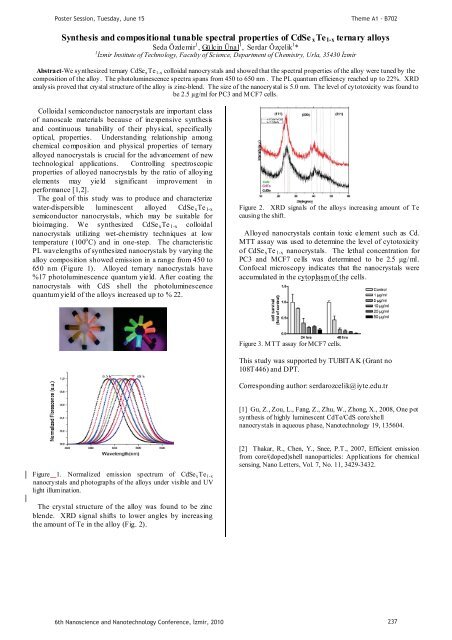Photonic crystals in biology
Photonic crystals in biology
Photonic crystals in biology
Create successful ePaper yourself
Turn your PDF publications into a flip-book with our unique Google optimized e-Paper software.
Poster Session, Tuesday, June 15<br />
Theme A1 - B702<br />
Synthesis and compos itional tunable spectral properties of CdSe x Te 1-x ternary alloys<br />
Seda Özdemir 1 , Gü lç<strong>in</strong> Ünal 1 ,Serdar Özçelik 1 *<br />
<br />
1<br />
Abstract-We synthesized ternary CdSe xTe 1-x colloidal nano<strong>crystals</strong> and showed that the spectral properties of the alloy were tuned by the<br />
composition of the alloy. The photolum<strong>in</strong>escence spectra spans from 450 to 650 nm . The PL quantum efficiency reached up to 22%. XRD<br />
analysis proved that crystal structure of the alloy is z<strong>in</strong>c-blend. The size of the nanocrystal is 5.0 nm. The level of cytotoxicity was found to<br />
be 2.5 μg/ml for PC3 and MCF7 cells.<br />
Colloidal semiconductor nano<strong>crystals</strong> are important class<br />
of nanoscale materials because of <strong>in</strong>expensive synthesis<br />
and cont<strong>in</strong>uous tunability of their physical, specifically<br />
optical, properties. Understand<strong>in</strong>g relationship among<br />
chemical composition and physical properties of ternary<br />
alloyed nano<strong>crystals</strong> is crucial for the advancement of new<br />
technological applications. Controll<strong>in</strong>g spectroscopic<br />
properties of alloyed nano<strong>crystals</strong> by the ratio of alloy<strong>in</strong>g<br />
elements may yield significant improvement <strong>in</strong><br />
performance [1,2].<br />
The goal of this study was to produce and characterize<br />
water-dispersible lu m<strong>in</strong>escent alloyed CdSe x Te 1-x<br />
semiconductor nano<strong>crystals</strong>, which may be suitable for<br />
bioimag<strong>in</strong>g. We synthesized CdSe x Te 1-x colloidal<br />
nano<strong>crystals</strong> utiliz<strong>in</strong>g wet-chemistry techniques at low<br />
temperature (100 o C) and <strong>in</strong> one-step. The characteristic<br />
PL wavelengths of synthesized nano<strong>crystals</strong> by vary<strong>in</strong>g the<br />
alloy composition showed emission <strong>in</strong> a range from 450 to<br />
650 nm (Figure 1). Alloyed ternary nano<strong>crystals</strong> have<br />
%17 photolum<strong>in</strong>escence quantum yield. After coat<strong>in</strong>g the<br />
nano<strong>crystals</strong> with CdS shell the photolum<strong>in</strong>escence<br />
quantum yield of the alloys <strong>in</strong>creased up to % 22.<br />
Figure 2. XRD signals of the alloys <strong>in</strong>creas<strong>in</strong>g amount of Te<br />
caus<strong>in</strong>g the shift.<br />
Alloyed nano<strong>crystals</strong> conta<strong>in</strong> toxic element such as Cd.<br />
MTT assay was used to determ<strong>in</strong>e the level of cytotoxicity<br />
of CdSe x Te 1-x nano<strong>crystals</strong>. The lethal concentration for<br />
<br />
Confocal microscopy <strong>in</strong>dicates that the nano<strong>crystals</strong> were<br />
accumulated <strong>in</strong> the cytoplasm of the cells.<br />
Figure 3. MTT assay for MCF7 cells.<br />
This study was supported by TUBITAK (Grant no<br />
108T446) and DPT.<br />
Correspond<strong>in</strong>g author: serdarozcelik@iyte.edu.tr<br />
[1] Gu, Z., Zou, L., Fang, Z., Zhu, W., Zhong, X., 2008, One pot<br />
synthesis of highly lum<strong>in</strong>escent CdTe/CdS core/shell<br />
nano<strong>crystals</strong> <strong>in</strong> aqueous phase, Nanotechnology 19, 135604.<br />
[2] Thakar, R., Chen, Y., Snee, P.T., 2007, Efficient emission<br />
from core/(doped)shell nanoparticles: Applications for chemical<br />
sens<strong>in</strong>g, Nano Letters, Vol. 7, No. 11, 3429-3432.<br />
Figure 1. Normalized emission spectrum of CdSe x Te 1-x<br />
nano<strong>crystals</strong> and photographs of the alloys under visible and UV<br />
light illum<strong>in</strong>ation.<br />
The crystal structure of the alloy was found to be z<strong>in</strong>c<br />
blende. XRD signal shifts to lower angles by <strong>in</strong>creas<strong>in</strong>g<br />
the amount of Te <strong>in</strong> the alloy (Fig. 2).<br />
6th Nanoscience and Nanotechnology Conference, zmir, 2010 237













